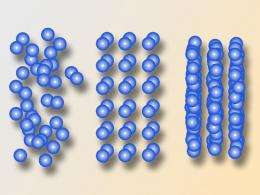Flowing structures in soft crystals

What is common to blood, ink and gruel? They are all liquids in which tiny particles are suspended – so called “colloids”. In some of these liquids, the particles form groups (clusters), which form regular structures, much like atoms in a crystal. A team of researchers from TU Vienna and Vienna University has now managed to study the remarkable properties of these crystal-like substances in computer simulations. Under mechanical strain, the crystalline pattern can change into a different structure, or it can vanish completely.
The researchers anticipate a broad range of practical applications for these effects. The results of their calculations have now been published in the scientific journal Physical Review Letters.
Regular Structures in Liquids
If small particles accumulate, they can form clusters. Within a cluster, the particles may overlap and mingle, similar to a densely packed shoal of eels, gliding past each other. Remarkably, these clusters are not situated at random positions, but they spontaneously form a regular structure – a “cluster crystal”. The distance between two neighboring clusters is constant. “Increasing the density of particles adds more and more particles to each cluster – but the distance between them stays the same”, says Arash Nikoubashman, PhD-student at TU Vienna. He made the calculations together with Professor Gerhard Kahl (Institute for Theoretical Physics, TU Vienna) and Professor Christos Likos (University of Vienna).
Crystal Structure Turning into Strings
“Previous results had already led us to believe that these particles could exhibit strange behavior under certain external conditions”, the physicists explain. And their hopes were not unfounded: in computer simulations they managed to calculate how the crystal-like structure behaves under mechanical strain that causes shears stress – which means that surfaces within the liquid are shifted relative to each other. At first, the crystal structure starts to melt, the connections between the clusters are broken. From these molten particle clusters, a new regular order starts to emerge spontaneously. Long, straight strings of particle are formed, neatly aligned in parallel.
Thin and Thick
While these strings are created, the liquid gets thinner, its viscosity decreases. This is due to the strings being able to slide relative to one another. If the material is subject to even more strain, the strings break up too, a “molten” unstructured ensemble of particle clusters remains, and the viscosity of the liquid increases again. More and more particles are washed away from their original positions and inhibit the flow. This behavior is the same for all kinds of cluster crystals. With a simple theoretical model, the critical strain, at which the ordered structure vanishes completely, can be predicted very accurately.
Under shear strain, crystals made of soft, penetrable particles can exhibit new kinds of self-organization. Geometric structures emerge, governed by the kind of forces acting between the particles. This research in the field of “soft matter” in the micro- and nanometer regime is not only interesting from a theoretical point of view. These materials play an important role in our everyday life – such as blood or large biopolymers like DNA. They are important in biotechnology, and also in petrochemistry and pharmacology – wherever tailor-made nano materials are being used. A liquid which can change its viscosity under mechanical stress promises a broad spectrum of possible applications – ranging from vibration dampers to protective clothing.
More information: Arash Nikoubashman, et al., Cluster Crystals under Shear, Phys. Rev. Lett. 107, 068302 (2011). DOI: 10.1103/PhysRevLett.107.068302
Provided by Vienna University of Technology




















